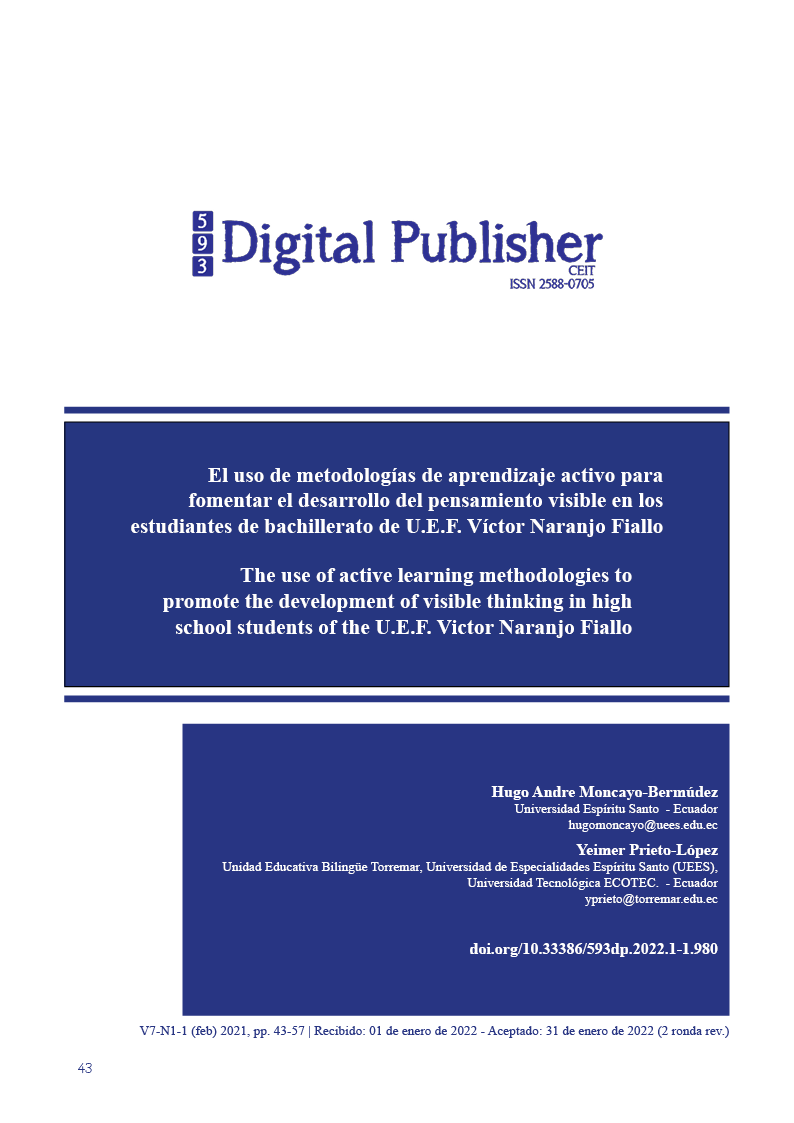The use of active learning methodologies to promote the development of visible thinking in high school students of the U.E.F. Victor Naranjo Fiallo
Main Article Content
Abstract
Education in the twenty-first century must be formed as an interactive process between teachers and students where the capacity to integrate information and communication technology must be enhanced in order to enable students to achieve better utilization and development of skills, the present research study proposes the establishment of learning methodologies that allow students the construction of their own knowledge through the implementation of new pedagogical trends that encourage active participation for their intellectual formation through the formation of a constructive and non-receptive process. This paper presents as a general objective to propose the implementation of methodologies focused on the development of the stimulation of visible thought in the high school students of the Víctor Naranjo Fiallo Fiscal Educational Unit. A qualitative and quantitative approach was used to assist in the collection and analysis of the data, where a survey was used, to know the needs of the educational center for the implementation of active learning methodologies.
Downloads
Article Details

This work is licensed under a Creative Commons Attribution-NonCommercial-ShareAlike 4.0 International License.
1. Derechos de autor
Las obras que se publican en 593 Digital Publisher CEIT están sujetas a los siguientes términos:
1.1. 593 Digital Publisher CEIT, conserva los derechos patrimoniales (copyright) de las obras publicadas, favorece y permite la reutilización de las mismas bajo la licencia Licencia Creative Commons 4.0 de Reconocimiento-NoComercial-CompartirIgual 4.0, por lo cual se pueden copiar, usar, difundir, transmitir y exponer públicamente, siempre que:
1.1.a. Se cite la autoría y fuente original de su publicación (revista, editorial, URL).
1.1.b. No se usen para fines comerciales u onerosos.
1.1.c. Se mencione la existencia y especificaciones de esta licencia de uso.
References
Acosta, R., Martín, A., & Hernández, A. (2019). Uso de las Metodologías de Aprendizaje Colaborativo con TIC: Un análisis desde las creencias del profesorado. Revista digital Educación(35), 309 - 324.
Albarrán, F., & Díaz, C. (2021). Metodologías de aprendizaje basado en problemas, proyectos y estudio de casos en el pensamiento crítico de estudiantes universitarios. Revista de Ciencias Médicas de Pinar del Río, 25(3), 10.
Ayala, M., Prieto, Y., & Pizarro, J. (2021). La pedagogía de la enseñanza del pensamiento: Hacer visible el pensamiento. Revista Digital Publisher CEIT, 6(4), 177 - 183. Obtenido de https://www.593dp.com/index.php/593_Digital_Publisher/article/view/517
Bravo, G., & Vigueras, J. (2021). Metodologías Activas en el proceso de enseñanza – aprendizaje del idioma inglés. Revista Polo del Conocimiento, 6(2), 4694 - 482.
Bravo, R. (2020). La declaración PRISMA 2020: una guía actualizada para la publicación de revisiones sistemáticas. Declaración PRISMA 2020. Obtenido de https://ccamposhugf.files.wordpress.com/2021/04/prisma_2020_statement_definitivo-espanol-completo.pdf
Cano, Y., Aguiar, J., & Mendoza, M. (2019). Metodologías activas: una necesidad en la Unidad Educativa Reino de Inglaterra. Revista Educación, 43(2), 1 - 10.
Cañas, M., Pinedo, R., & García, N. (2021). La promoción y la enseñanza de las habilidades del pensamiento profundo y visible en las sesiones de Educación Física en Educación Primaria. Revista Retos(41), 387 - 399. Obtenido de https://recyt.fecyt.es/index.php/retos/article/view/84139/63667
Cevallos, L., & Guijarro, A. (2017). Metodologías de enseñanza-aprendizaje exigencia o paradigma en la Universidad del siglo XXICaso de estudio: Universidad de Guayaquil. Revista Publicando, 10(1), 131 - 146.
Civarolo, M., & Pérez, M. (2019). Prácticas docentes que promueven pensamiento visible y comprensión disciplinar, a partir de expresiones metafóricas. Anuario Digital de Investigación Eduactiva(2), 63 - 74. Obtenido de http://revistas.bibdigital.uccor.edu.ar/index.php/adiv/article/view/4216/2810
Espejo, R., & Sarmiento, R. (2017). Metodologías activas para el aprendizaje (Primera Edición ed.). Santiago de Chile: Universidad Central.
Gil, C., & Manso, A. (2021). Visibilizar el pensamiento a través de la enseñanza de las ciencias experimentales en Educación Infantil. Revista Eureka sobre Enseñanza y Divulgación de las Ciencias, 19(1), 120. Obtenido de https://www.redalyc.org/journal/920/92068491001/html/
Giraldez, A. (2019). Los docentes debemos integrar el pensamiento visible en todas las etapas. Revista Educación 3.0, 5. Obtenido de ducaciontrespuntocero.com/entrevistas/pensamiento-visible-educacion/
Gómez, I., Rubiano, E., & Gil, P. (2020). Manual para el desarrollo de la metodología activa y el pensamiento visible en el aula. Revista Estudios sobre Educación, 39, 331 - 334. Obtenido de https://media.proquest.com/media/hms/PFT/1/3TJBI?_s=I%2B8M1t4pFtEiJPrmVUtpPb0aKFQ%3D
Jordán, C. (2019). Las rutinas de pensamiento en Educación Infantil. Revista Digitral Docente Campus Educación, 5.
Llanga, E., & López, C. (2019). Metodología del docente y el aprendizaje. Revista Atlante, 2, 5.
López, L., & De Pro, A. (2020). Pensamiento visible en la educación inical: Transformaciones para el siglo XXI. Revista Horizontes Pedagógicos, 22(2), 62 - 75. Obtenido de https://horizontespedagogicos.ibero.edu.co/article/view/hop.22203/1630
Marín, S., & Rodríguez, M. (2021). Hacer el pensamiento visible para el fortalecimiento de las habilidades comunicativas en inglés de niños de transición. Colombian Applied Linguistics Journal, 23(1), 10.
Ministerio de Educación. (2019). Guía metodológica para docentes facilitadores del Programa de Participación Estudiantil (PPE) (Primera Edición ed.). Quito: MinEduc.
Ministerio de Educación. (2021). La interacción: un elemento clave para el aprendizaje en un entorno virtual (Primera Edición ed.). Quito: MinEduc. Subsecretaría de Educación Especializada e Inclusiva.
Navarro, D., & Samón, M. (2017). Redefinición de los conceptos método de enseñanza y método de aprendizaje. Revista Edusol, 17(60), 26 - 33.
Pinedo, R., García, N., & Cañas , M. (2017). Innovación educativa mediante el uso de Metodologías activas y estrategias de pensamiento visible en la formación inicial del profesorado. El Salvador: Scinfoper.
Pinedo, R., García, N., & Cañas, M. (2017). Innovación educativa mediante el uso de metodologías activas y estrategias de pensamiento visible en la formación inicial del profesorado. En J. Nuñéz, M. Pérez, M. Molero, J. Gárquez, & Á. Martos, Temas actuales de investigación en las áreas de la Salud y la Educación (Primera Edición ed., pág. 1046). El Salvador: SCINFOPER. Obtenido de https://www.researchgate.net/profile/Zaira-Santana-Amador/publication/326410449_Nueva_metodologia_para_el_tratamiento_del_TDAH_mediante_el_ejercicio_fisico/links/5df0d049299bf10bc352073e/Nueva-metodologia-para-el-tratamiento-del-TDAH-mediante-el-ejercicio
Restrepo, R., & Waks, L. (2018). Aprendizaje activo para el aula: Una síntesis de fundamentos y técnicas. Observatorio Unae. Obtenido de https://unae.edu.ec/wp-content/uploads/2019/11/cuaderno-2.pdf
Rochina, S., Ortíz, J., & Paguay, L. (2020). La metodología de la enseñanza aprendizaje en la educación superior: algunas reflexiones. Revista Universidad y Sociedad, 12(1), 8.
Sanglier, G. (2021). Qué es el ‘pensamiento visible’ y cómo se puede aplicar en el aula. (A. País, Ed.) El Mostrador, pág. 5.
Sanz, R., Berrón, E., & Monreal, I. (2021). Educación y pedagogía (Primera Edición ed.). Arts Educa. Obtenido de https://www.e-revistes.uji.es/index.php/artseduca/article/view/5743/6643
Sepúlveda, Y., Soto, M., & Hernández, R. (2018). Visibilización del pensamiento: una experiencia de implementación pedagógica. Revista Gestión de la innovación en Eduicación Superior, 3, 125 - 158.
Sepúlveda, Y., Soto, M., & Hernández, R. (2018). Visibilización del pensamiento: una experiencia de implementación pedagógica. Revista de Gestión de la Innovación en Educación Superior REGIES, 3, 125 - 158. Obtenido de http://ojs.inacap.cl/index.php/regies/article/view/93/61
Silva, J., & Maturana, D. (2017). Una propuesta de modelo para introducir metodologías activas en educación superior. Revista Innovación educativa (México, DF), 17(73), 10.
Soto, J., Martínez, M., Alonso, J., & Gámez, J. (2019). Estrategias y metodologías didácticas (Primera Edición ed.). The Netherlands: Adaya Press.
Vera, R., Castro, C., Estves, Estévez, I., & Maldonado, K. (2020). Metodologías de enseñanza-aprendizaje constructivista aplicadas a la educación superior. Revista Sinapsis, 3(18), 1 - 9.



